A History of the County of Rutland: Volume 2. Originally published by Victoria County History, London, 1935.
This free content was digitised by double rekeying. All rights reserved.
'Parishes: Clipsham', in A History of the County of Rutland: Volume 2, ed. William Page (London, 1935), British History Online https://prod.british-history.ac.uk/vch/rutland/vol2/pp41-45 [accessed 23 April 2025].
'Parishes: Clipsham', in A History of the County of Rutland: Volume 2. Edited by William Page (London, 1935), British History Online, accessed April 23, 2025, https://prod.british-history.ac.uk/vch/rutland/vol2/pp41-45.
"Parishes: Clipsham". A History of the County of Rutland: Volume 2. Ed. William Page (London, 1935), British History Online. Web. 23 April 2025. https://prod.british-history.ac.uk/vch/rutland/vol2/pp41-45.
In this section
CLIPSHAM
Kilpesham, Kylpesham (xiii, xiv, xv cent.); Clyppesham, Clipsham (xv cent.).
The parish of Clipsham contains 1,669 acres of land, and lies on the borders of Lincolnshire. Geographically it lies in the hundred of Alstoe, but it was included first in the hundred of Martinsley and afterwards in the soke of Oakham (q.v.), which was formed of the townships and manors held of the castle and manor of Oakham. (fn. 1) The land is fairly level, being generally about 300 ft. above Ordnance datum, and is mostly pasture and woodland, Clipsham Park, Clipsham Park Wood and Allah Wood occupying a large part of the parish.
The straggling village lies along the road from the Great North Road at Stretton to Little Bytham. It is 3½ miles west of Little Bytham Station, on the London and North Eastern Railway, and 2 miles south of Castle Bytham Station, on the London Midland and Scottish Railway.
On the western side of the village there are some picturesque farmhouses built and roofed with local stone, having for a background Clipsham Park, with its trees and good grass land. The old manor-house, in the middle of the village, is an interesting twostory gabled stone building of simple design, erected in the first half of the 17th century, with low mullioned windows and good wind-break chimneys. It is H-shaped in plan, with attics in the end wings, and the roof is covered with stone slates. Near to it, on the west, is another 17th-century house of the same type, but different in plan and in less perfect state, with a two-story bay window towards the road, and gabled north wing. The cottages in the eastern part of the village are of stone and roofed with slates or tiles; the Park Wood beyond them gives a pleasant view. It is probable that, as in many parts of Rutland, the village was built round a rough square, formed here on the north side of the Stretton Road. The road halfway between the church and the Stretton Road, and parallel to it, was constructed some time in the last century by the then squire, and is still known as the New Road. There was a windmill in the parish in 1686. (fn. 2)
Clipsham Hall, the residence of Mr. John Davenport-Handley-Humphreys, J.P., which lies to the north-east of the church, was rebuilt of the local stone in the 18th century, and is a plain but well-designed house of two stories, with slightly projecting pedimented middle portion, cornice and stone-slated hipped roof. A semicircular pillared porch on the east or principal front is a later addition, and at the north end are considerable remains of the older house, including two mullioned windows and a panel with the arms of Harington, dated 1582. (fn. 3)
Quarries of excellent freestone, near Pickworth Wood, are still worked, and the stone from them is being used for the restoration at present being carried out on the Houses of Parliament. In 1556 a mason named Roger Warde, writing to Sir William Cecil about the building materials he should use, remarks that 'the best stone for stairs is to be had at Clypsham.' (fn. 4) There were 80 houseling people in the parish in 1548. (fn. 5)
Manor
The manor of CLIPSHAM is not mentioned in Domesday Book (1086), but it was presumably in the king's hands until granted away with the manor and castle of Oakham by Henry I in the 12th century. From this time it was held of the Castle of Oakham by the service of one knight's fee, (fn. 6) and formed part of Oakham Soke. The first recorded tenant of the manor seems to have been William de Freney (de Fraisneto), against whom the Templars brought a plea of warranty for 4 bovates of land in Clipsham in 1203. (fn. 7) From this date the manor followed the descent of that of Belton (q.v.). The lands of Reginald de Freney which had been forfeited as lands of a Norman would have escheated to the overlord, Henry de Ferrers, lord of Oakham. (fn. 8) In 1205 John de Freney (du Frenai) farmed the lands of Henry de Ferrers, (fn. 9) who as a Norman had also forfeited his lands in England. John de Freney appears as lord of the manor of Clipsham in 1209 and 1218, (fn. 10) and between 1219 and 1226 his heir was in the wardship of Roger de Cantilupe. (fn. 11) In 1232 Henry de Freney received seisin of the lands in Belton forfeited by Reginald his father as a Norman. (fn. 12) The lands at Clipsham probably passed at the same time, as Henry son of Reginald de Freney sold 100s. worth of land in Belton to Hugh de Mortimer. (fn. 13) At the death of Hugh in 1227 these lands passed to his mother Isabel, sister of Hugh de Ferrers, (fn. 14) who was holding them in 1244. (fn. 15) Probably the manor of Clipsham was not sold with Belton, as Peter de Freney, possibly the son of John de Freney, conveyed the manor in 1244 to William de Cantilupe. (fn. 16) In 1245 Cantilupe obtained a grant of free warren, (fn. 17) and died in 1254. He was succeeded by his son George de Cantilupe, (fn. 18) whose heirs were his nephew, John de Hastings, and his sister, Millicent, who divided his possessions on his death in 1273. (fn. 19) Clipsham was assigned to Millicent, the wife of Eudo la Zouche. In 1296, as Millicent de Monte Alto, she made provision for her son, William la Zouche, and his wife Maud. (fn. 20) She died in 1298, and William la Zouche succeeded her, (fn. 21) and was recorded as holding one fee in Clipsham in 1300 and later. (fn. 22) In 1317 he granted the manor for their lives to his younger sons William, John and Roger, who were to pay £20 a year to him for his life, and then a rose yearly to his heirs. (fn. 23) The manor had reverted to him before 1351, when he settled it on his grandson William la Zouche, (fn. 24) who succeeded him in 1352. (fn. 25) His descendants held the manor of Clipsham until 1485, (fn. 26) when John, Lord Zouche, having fought for Richard III at Bosworth, (fn. 27) was attainted, and Henry VII granted it to his esquire, David Philip. (fn. 28) Zouche recovered his honours in 1495, (fn. 29) and some of his lands, including Clipsham, which his son and heir John sold in 1539 to Sir John Harington. (fn. 30) The latter died seised of it in 1553, and was succeeded by his son James (fn. 31) and grandson John, (fn. 32) who was created Baron Harington of Exton in 1603. (fn. 33) Lord Harington died at Worms, when accompanying Princess Elizabeth on her marriage journey in 1613. (fn. 34) His son and heir John died a few months later, and Clipsham passed to his eldest sister and co-heir Lucy, Countess of Bedford. (fn. 35) Edward, Earl of Bedford, sold the manor in 1614 to his wife's cousin, Francis Stacy, (fn. 36) who in turn sold it in 1618 to Robert Johnson, Archdeacon of Leicester. (fn. 37) In 1623 the Archdeacon settled it on his grandson Isaac, on his marriage with Lady Arabella Fiennes. (fn. 38) He died in 1625 (fn. 39) and Isaac, who emigrated to America, in 1630, (fn. 40) leaving no children. The manor passed under the settlement to his half-brothers Samuel, who died in 1658, (fn. 41) and Ezekiel, who owned it in 1686. (fn. 42) Rents from Clipsham and other manors were payable to Thomas Johnson of Olney (co. Buck.) and Anne his wife, (fn. 43) and to Thomas Marsh and Margaret his wife, Anne and Margaret being daughters of Ezekiel. (fn. 44) By his will proved in 1688 (fn. 45) Ezekiel left his grandson, William Johnson, his heir, and legacies to his granddaughters Anne Johnson and Elizabeth and Martha Marsh. Ezekiel, however, had sold the manor in 1686 to Richard Snow of Staple Inn, (fn. 46) who in 1699 also bought other property in Clipsham from Elizabeth Fawkener, widow and devisee of Anthony Fawkener, clk. (fn. 47) Snow died in 1739, and was succeeded by his son Matthew (d. 1757), grandson, the Rev. Paul George Snow, the rector of Clipsham, and great-grandson, the Rev. Matthew Snow. (fn. 48) The last was lord of the manor in 1802, (fn. 49) but died in 1809, when his sisters became his heirs. The eldest, Jane, married in 1784 John Paget of Cranmore Hall, Somerset, and left a son John Moore Paget, (fn. 50) who sold Clipsham in 1865, a year before he died, to John Handley, sometime M.P. for Newark. His daughter married William Davenport Davenport of Bramhall, Cheshire (d. 1869), and her son, who took the additional names of Handley (1881) and Humphreys (1910), became lord of the manor. He died in 1914, and his son Mr. John Davenport-HandleyHumphreys, of Clipsham Hall, is now lord of the manor. (fn. 51)
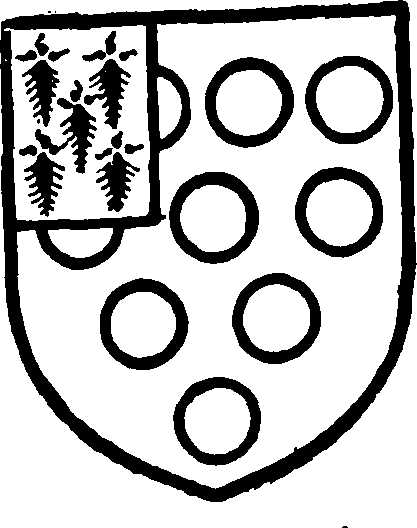
Zouche of Harringworth. Gules bezanty with a quarter ermine.
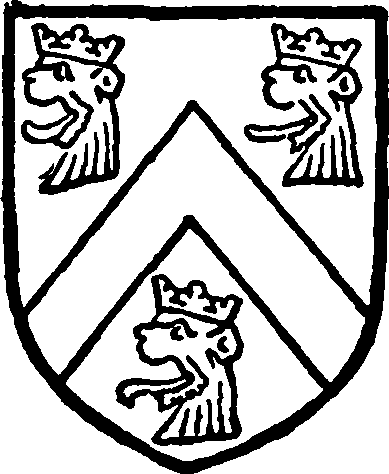
Johnson of North Luffenham. Argent a cheveron sable between three lions' heads gules cut off at the neck and crowned or.
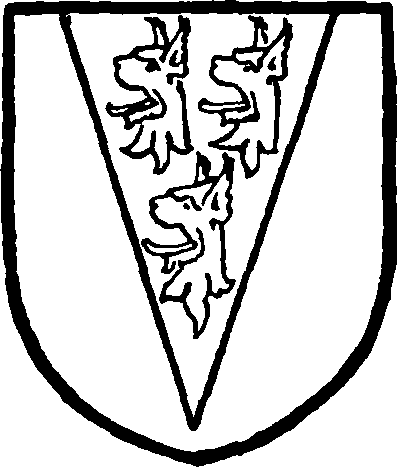
Johnson of Olney. Argent a pile azure with three ounces' heads razed argent thereon.
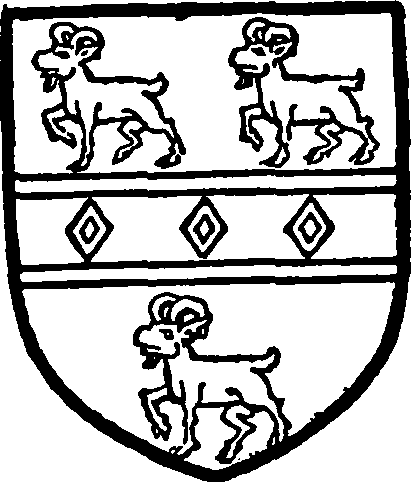
Handley. Argent three voided lozenges set fessewise between two bars gules and three goats passant sable.
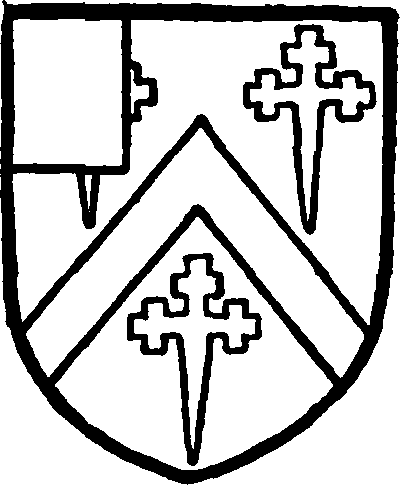
Davenport. Argent a cheveron between three crosslets fitchy sable with a quarter azure.
A view of frankpledge is mentioned in the sale of the manor to Archdeacon Robert Johnson in 1618. (fn. 52)
Church
The church of ST. MARY consists of chancel 27 ft. 3 in. by 13 ft. 6 in., with north aisle 8 ft. wide, clearstoried nave 36 ft. 4 in. by 13 ft. 6 in., north and south aisles each 13 ft. wide, south porch and engaged west tower 9 ft. 9 in. square, all these measurements being internal. The tower is surmounted by a spire. The width across nave and aisles is 43 ft. 9 in.
The chancel has a modern high-pitched slated, eaved roof and the porch is covered with stone slates, but elsewhere the roofs are leaded and behind plain parapets. The building was extensively restored in 1858, when the north wall of the north aisle was rebuilt throughout its length, and the chancel aisle, which had long been destroyed, was re-erected. Internally all the walls are plastered.
The original 12th-century church seems to have been an aisleless building with short square-ended chancel, and probably a west tower. To the nave of this structure a north aisle was added c. 1190, the wall being pierced for the erection of the existing north arcade of three bays, the semicircular arches of which are of two orders, with a heavy half-round moulding on the soffit. Towards the aisle both orders are square, but on the nave side they have edge-rolls and in the westernmost arch one outer order of cheveron moulding enriched with leaves and pellets. The arches spring from cylindrical piers and half-round responds with square scalloped capitals and moulded bases on square chamfered plinths; the arches are without hood-moulds.
Early in the 13th century a south aisle was added to the nave and the chancel was apparently extended to its present length, the north-east buttress (fn. 53) and the lower part of the east wall being of this period. The south arcade, which was pierced through the old wall, (fn. 54) consists of three semicircular arches of two chamfered orders on cylindrical piers (fn. 55) and half-round responds, all with moulded capitals and high circular moulded bases. The shallow outer order has a series of ornamental stops, except over the east respond, in which the dog-tooth occurs twice, and the capitals of the piers are octagonal in shape, with nail-head ornament. There are no hoodmoulds. The respond capitals are circular, and that at the east end alone has nail-head enrichment. The bases stand on circular plinths.
Later in the same century the north aisle seems to have been extended to cover the chancel and the tower rebuilt. Shortly afterwards, probably early in the 14th century, the building underwent an extensive remodelling, by which it assumed the plan (fn. 56) and external appearance that it has since retained. The chancel was rebuilt in its present form (beginning with the upper part of the east wall and proceeding westward from the south-east angle), the nave aisles rebuilt and widened and extended westward to engage the tower, to which a spire was added, and the porch and clearstory were erected.
The chancel is of two bays and has a pointed east window of three trefoiled lights with reticulated tracery and hood-mould with head-stops; the 14thcentury sill string is taken round the south-east buttress, but the chamfered plinth at the east end belongs to the older lower part of the wall. But from the south-east angle of the chancel, westward as far as the tower, there is a moulded plinth, which is repeated along the north aisle in modern form. Of the two windows, each of two trefoiled lights, on the south side of the chancel, the westernmost is square-headed; the other, which is pointed and has geometrical tracery, is either modern or is very much restored. The narrow priest's doorway is also much restored. (fn. 57) On the north side the chancel is open to the aisle by an arcade of two wide pointed arches (fn. 58) of two chamfered orders with hood-mould on both sides, springing from a pier consisting of four clustered shafts with moulded capital and base and from similar shafted responds. The hood-moulds have notch-stops at the ends and a head above the pier. The arch between the aisles of chancel and nave, though much restored, is apparently contemporary; it is of two chamfered orders on moulded corbels supported by heads. The chancel and nave are of the same width and the arch between them is modern. (fn. 59) No ancient ritual arrangements remain. (fn. 60)
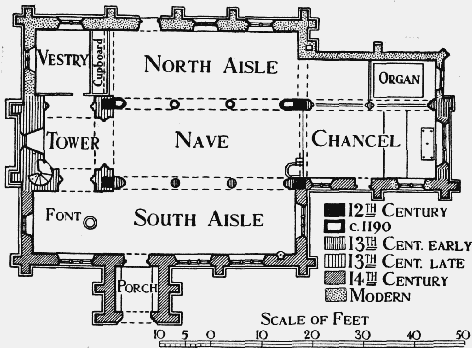
Plan of Clipsham Church
At the east end of the south aisle is a large pointed window of three trefoiled lights with curvilinear tracery, the outer hollow moulding of which is enriched all round with ball-flower and the hood-mould has head-stops representing a king and queen. The windows in the south wall, two east of the porch and one west of it, are square-headed and of three trefoiled lights with quatrefoil tracery: the west window is of two lights with a cusped triangle in the head. The south doorway has a continuous wave-moulding and hood with head-stops. In the usual position at the east end of the aisle is a pointed piscina with deeply recessed trefoil tracery, projecting fluted bowl and wooden shelf, and on either side of the east window an image bracket supported by a head. Externally there is a moulded sill string round the aisle and the buttresses are of two stages with triangular heads. The hollow moulding below the parapet is enriched with ball-flower (fn. 61) along the south wall, but not at the raking ends. The north aisle reproduces in modern form many of the same features, but the windows are of two lights and of different design. (fn. 62) The hollow moulding under the eaves of the porch has also ballflower enrichment. The much-restored porch has an outer pointed doorway of three continuous hollow chamfered orders and a trefoiled niche in the gable. The clearstory windows, three on each side, are squareheaded, and of two trefoiled lights without tracery.
The tower is of three stages, with moulded plinth, and a single-light trefoiled west window in the bottom stage. The vice is in the south-west angle, which is thickened at the second stage, where the western buttresses stop and the wall sets back, in the form of a slightly projecting clasping buttress. (fn. 63) The pointed bell-chamber windows are of two trefoiled lights, with soffit cusping, and quatrefoil in the head on the north and south sides; on the west the spandrel is solid. The openings have modern stone quatrefoil filling. The spire, which is of somewhat unusual design, rises from a cornice of notch-heads, immediately above which there is a short slope and shorter piece of upright walling crowned with coarsely constructed battlements, or diminutive turrets, behind which begins the spire proper, which is of the 'stone-timber' type, twice banded, with two tiers of gabled lights in the cardinal faces, each of two openings and surmounted by a cross. The angles are plain. Internally the tower opens into the nave by a pointed arch of three chamfered orders, the inner order on clustered responds with moulded capitals and bases, and into the aisles by similar but less lofty arches. (fn. 64)
The font has a 12th-century circular bowl with a band of hatched ornament round the rim, standing on a circular stem and moulded base. (fn. 65)
The oak pulpit and fittings are modern, and there are modern screens in the chancel arcade. The reredos has modern carvings of the Last Supper (after Leonardo da Vinci), Transfiguration and Ascension.
In the east window (fn. 66) of the chancel aisle are some pieces of old glass which are said to have been brought from the old church at Pickworth. They include shields with the arms of Thomas Neville of Pykale, the royal arms (France modern and England quarterly), the town of Stamford, and the royal arms of the Stewart sovereigns; there is also a Lancastrian rose.
The west end of the north aisle is used as a vestry, and the organ is at the east end of the chancel aisle. A carved panel with the arms of the Stewart sovereigns is in the vestry. There are no monuments earlier than 1738–9. (fn. 67)
There are three bells in the tower: the first dated 1671, the second by Tobie Norris (II) of Stamford 1675, and the tenor by Thomas Norris 1657. (fn. 68) On the timber framework supporting the clock is inscribed 'I.W. 1688.'
The plate consists of a cup and cover paten of 1691–2, with the maker's mark 'M.K.' On the cup is engraved a representation of Our Lord as the Good Shepherd with the lamb on His shoulder. (fn. 69) There is also a plated paten.
The early registers have been lost. Those before 1812 which remain are as follows: (i) baptisms and burials 1726–90, marriages 1726–54; (ii) baptisms and burials 1790–1812; (iii) marriages 1754–1812. (fn. 70)
Advowson
The advowson of the church of Clipsham belonged to the lords of the manor (fn. 71) at least since the time of John de Freney, who presented between 1209 and 1219. (fn. 72) At that time, however, a vicarage was in existence and the vicar paid a pension of 100s. to the rector and undertook all the duties of the church. (fn. 73) In 1679 Everard Fawkener presented to the rectory, presumably pro hac vice. (fn. 74) After the death of the Rev. Paul George Snow, in 1796, his widow Mary Snow presented in 1809 and 1816. (fn. 75)
At the present day Mr. John Davenport-HandleyHumphreys owns the advowson of the rectory. The benefices of Clipsham and Stretton are to be united at the first voidance of either rectory.
In 1337 William la Zouche, a king's clerk and Dean of York, together with Roger la Zouche, founded a chantry in the chapel of St. Nicholas in the church of Clipsham. (fn. 76) At the dissolution of the chantries it was endowed with lands and tenements in Rutland and Lincolnshire of the yearly value of 106s. 8d., from which a rent of 4d. a year was paid to the lord of Clipsham Manor. (fn. 77) The priest, named Richard Taylor, was described as' impotent, but of very honest report and conversation amongst his neighbours.' (fn. 78) The advowson of the chantry belonged to the lords of the manor, (fn. 79) and is mentioned in the sale of the manor (q.v.) in 1539 to James Harington. (fn. 80)
The lands of the chantry were, however, sold by Edward VI in 1553 to Thomas Reve and George Cotton to hold in fee. There was then a Chantry House, opposite the south side of the church yard, with some 7 acres of arable land and a close in Clipsham. (fn. 81)
The chantry of St. Maur is mentioned in the registers of Bishop Russell (1480–1494). (fn. 82)
A hermitage at Norewode, apparently in Clipsham parish, existed c. 1227, when a chaplain was presented to it by Roger de Cantilupe, (fn. 83) presumably as guardian of the heir of John de Freney. (fn. 84) The rector of Clipsham gave his consent and the rights of his and the neighbouring churches were reserved. (fn. 85)
There are no charities for this parish.